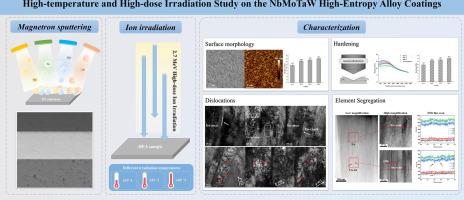NbMoTaW高熵合金涂层的高温大剂量辐照研究
IF 6.9
2区 材料科学
Q2 CHEMISTRY, PHYSICAL
引用次数: 0
摘要
高熵合金由于其优异的高温稳定性和耐辐射性,近年来作为先进核反应堆系统的候选材料受到了广泛的关注。为了了解NbMoTaW涂层在高温下的微观结构演变和力学性能,在450、550和600°C下,以2.7 MeV Si2+离子辐照NbMoTaW涂层,峰值损伤剂量为每原子50位位移。利用透射电子显微镜和纳米压痕对缺陷和辐照硬化进行了表征。辐照后未发现空洞,晶粒结构保持稳定。随着温度的升高,位错线变得更加扭曲,更难以滑动,从而导致高温辐照样品的硬化。位错环的平均尺寸略有增大,但仍保持在9 nm左右,位错环的密度呈波动趋势。随着温度的升高,晶界附近原有的微裂纹逐渐变窄,在600℃时消失。这可以归因于高温下的较大膨胀,在那里看不见的空位可以挤压这些微裂纹。这些空位应该是导致在600°C时发生最高辐照诱导硬化的关键因素之一。此外,在600°C时,在晶界处观察到辐照偏析。本文章由计算机程序翻译,如有差异,请以英文原文为准。


High-temperature and high-dose irradiation study on the NbMoTaW high-entropy alloy coatings
Due to its excellent high-temperature stability and radiation resistance, high-entropy alloys (HEAs) have attracted wide attention as candidate materials for advanced nuclear reactor systems recently. To understand their microstructure evolution and mechanical performance at high irradiation temperatures, NbMoTaW coatings were irradiated with 2.7 MeV Si2+ ions to a high peak damage dose of 50 displacements per atom at 450, 550 and 600 °C. Transmission Electron Microscopy and nanoindentation were used to characterize the defects and irradiation-induced hardening. No voids were observed and the grain structure kept stable after irradiated. As the temperature increases, dislocation lines become more distorted and harder to slip, contributing to hardening in high-temperature irradiated samples. The average size of dislocation loops increases slightly but remains approximately 9 nm, and the density of dislocation loops exhibits a fluctuating tendency. The pre-existed microcracks near grain boundaries became narrower with the elevation of temperature and disappeared at 600 °C. It can be attributed to the larger swelling at higher temperature, where the invisible vacancies could squeeze these microcracks. These vacancies should be one of the key factor leading to the highest irradiation-induced hardening occurred at 600 °C. In addition, irradiation segregations were observed at grain boundaries at 600 °C.
求助全文
通过发布文献求助,成功后即可免费获取论文全文。
去求助
来源期刊

Applied Surface Science
工程技术-材料科学:膜
CiteScore
12.50
自引率
7.50%
发文量
3393
审稿时长
67 days
期刊介绍:
Applied Surface Science covers topics contributing to a better understanding of surfaces, interfaces, nanostructures and their applications. The journal is concerned with scientific research on the atomic and molecular level of material properties determined with specific surface analytical techniques and/or computational methods, as well as the processing of such structures.
 求助内容:
求助内容: 应助结果提醒方式:
应助结果提醒方式:


